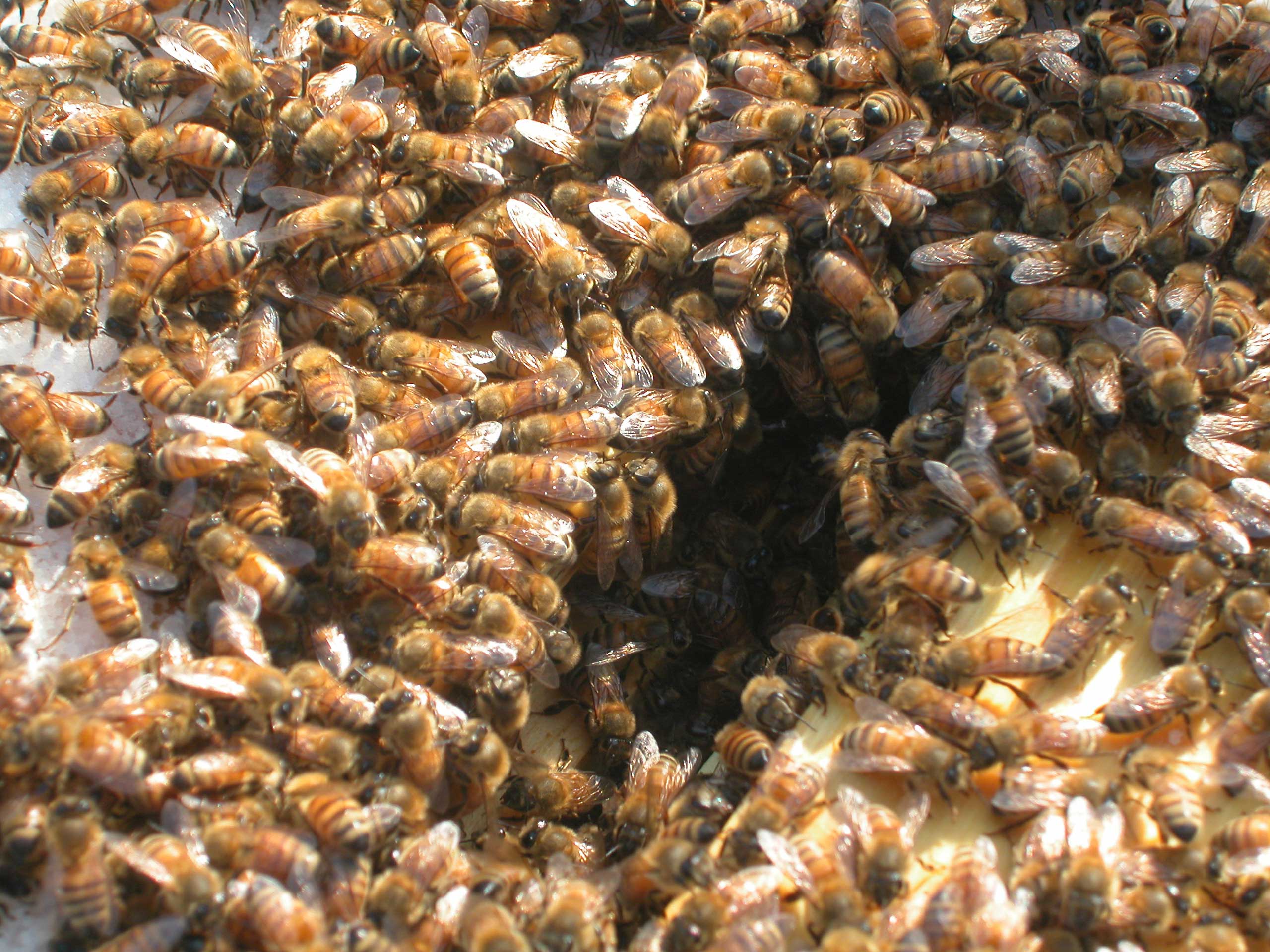 Let's confess this up front: I did not want to visit my hives today, because it seemed inevitable that the news would not be good. MaryEllen lost a hive yesterday, and she found out that 10 of the 12 hives at the University of Delaware had also perished. This truly bent me out of shape, because I went to a talk by the UDel head apiarist last Fall, and he appeared to be doing everything right as he tucked his bees in for the Winter. I know I did not do as much, so I feared that Twain and MaryEllen-the-Beehive might be dead.
Let's confess this up front: I did not want to visit my hives today, because it seemed inevitable that the news would not be good. MaryEllen lost a hive yesterday, and she found out that 10 of the 12 hives at the University of Delaware had also perished. This truly bent me out of shape, because I went to a talk by the UDel head apiarist last Fall, and he appeared to be doing everything right as he tucked his bees in for the Winter. I know I did not do as much, so I feared that Twain and MaryEllen-the-Beehive might be dead.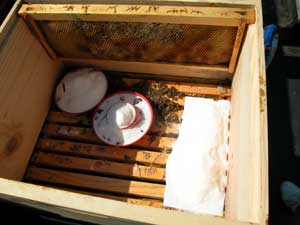 But, my dear friends, I cannot tell you what it does to my heart to see all those thousands of golden girls still buzzing! The bees were clearly in flight this morning, because my yard was full of scouts, looking for blooms. That meant one of the roof colonies was certainly alive, but could I hope for both? Well, the photo on the left shows the top of the cluster still peeking out at the Twain hive, and there were not very many new dead bees around (I have not been showing you the pictures, but since the worst of the cold snap ended, I have removed thousands of bees from in front of Twain, and have taken photos at one day intervals to see if a crash — like the one at the Mill — might be taking place).
But, my dear friends, I cannot tell you what it does to my heart to see all those thousands of golden girls still buzzing! The bees were clearly in flight this morning, because my yard was full of scouts, looking for blooms. That meant one of the roof colonies was certainly alive, but could I hope for both? Well, the photo on the left shows the top of the cluster still peeking out at the Twain hive, and there were not very many new dead bees around (I have not been showing you the pictures, but since the worst of the cold snap ended, I have removed thousands of bees from in front of Twain, and have taken photos at one day intervals to see if a crash — like the one at the Mill — might be taking place).The Wilde hive has finally risen up to the top box, and those girls are nibbling sugar, too. I had taken away all the feeders with 2:1 sugar syrup a week ago in order to better monitor bee death around the hive, but the bees found those feeders (at the other end of the roof) and were thronging them today. I set out some sugar water downstairs in the yard, too.
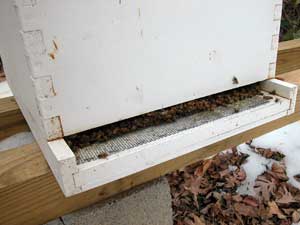 At the Monastery, I had grave fears for the MaryEllen colony. Their hive entrance had been almost stopped up with dead bees when I visited there last week. I cleared it, opened the entrance reducer a bit more, and gave them additional dry cane sugar (they had eaten a bit). Then I officially began to worry. It's hard to know exactly when worrying is warranted, especially since I do so much of it here. I tried to remember that, during the cold snap, the bees could not clean their home: they would have had to leave the cluster of warm bees to do it, and would have died themselves. Therefore a few weeks of deceased bees had piled up. What is too much? Only Spring can tell.
At the Monastery, I had grave fears for the MaryEllen colony. Their hive entrance had been almost stopped up with dead bees when I visited there last week. I cleared it, opened the entrance reducer a bit more, and gave them additional dry cane sugar (they had eaten a bit). Then I officially began to worry. It's hard to know exactly when worrying is warranted, especially since I do so much of it here. I tried to remember that, during the cold snap, the bees could not clean their home: they would have had to leave the cluster of warm bees to do it, and would have died themselves. Therefore a few weeks of deceased bees had piled up. What is too much? Only Spring can tell.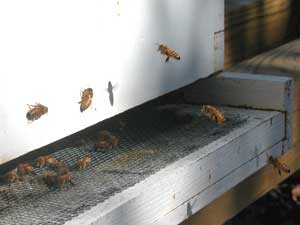 But today, I took the picture (way) above of the bees in the Doug colony, munching sugar for all they are worth, as well as this shot of the MaryEllen bees lining up for landing (like jets following I-95 to Newark...) packing pollen in three colors (one willow-grey, one maple-yellow, and one mystery-neon-orange). The Doug hive is clearly stronger, but I think there is reason to hope they both will make it.
But today, I took the picture (way) above of the bees in the Doug colony, munching sugar for all they are worth, as well as this shot of the MaryEllen bees lining up for landing (like jets following I-95 to Newark...) packing pollen in three colors (one willow-grey, one maple-yellow, and one mystery-neon-orange). The Doug hive is clearly stronger, but I think there is reason to hope they both will make it. And let us take a moment here to say "All hale the fuzzy male!" Why? Because every few minutes, a fat and furry drone would make his way to the hive entrance, and fly off to cruise queens. Somewhere out there is a Drone Congregating Area (a DCA), literally a great 7-11 in the sky, where willing males with not a whole lot of impulse control seek female joy. I'm going to read up on DCAs, and see if I can find any in the city.
There certainly are a lot of pictures today, but I just want to show you how the Doug hive got more sugar today. You saw above that the bees were thronging, and just pouring sugar on them could bury the poor buzzers. So I sprinkled sugar over them to make them retreat, then I filled in the empty areas with more sugar. The final picture shows you bees eating sugar at the MaryEllen colony. It looks like ice and snow, but it is bee-bitten sugar lace.
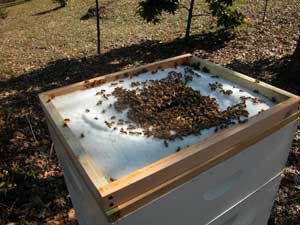
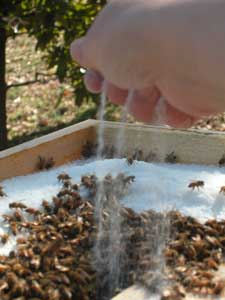
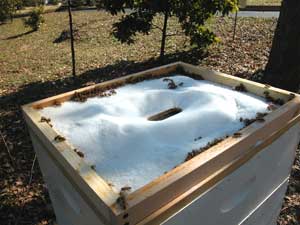
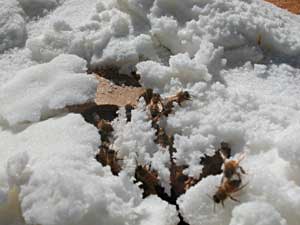
We are not in the clear, but now hope seems like a much more plausible, and pleasurable, way to pass the late Winter.
3 comments:
Hi Toni,
Look at all those golden bees! And the grass is greening up as well.
It's quite interesting to take the cover off a healthy hive early in the spring. Those sights, sounds, and smells foster hope.
Keep them fed and don't risk chilling/disturbing the brood by breaking the boxes apart. It's just too early yet.
Regards
BWrangler
Thinking life is good
I assume that there's plenty of clear warm water really close to the colonies in order to melt all this dry sugar! What's the temperature really during the day and night?
This is a good point. Feeding dry sugar could be a problem where there is not enough water -- like in less humid environments -- but around here the cluster creates adequate condensation (steam rising and then cooling on the hive cover) to give the bees a nearby, clean water source. I hesitated to use this feeding method until I spoke with beekeepers I knew pretty well, and tried it a little on my own girls before committing.
Post a Comment